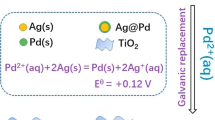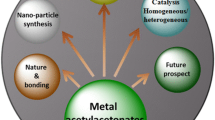Abstract
Molybdate sulfonic acid (MSA) as a highly efficient catalyst was synthesized and employed for the synthesis of octahydroxanthene-1,8-dione derivatives. MSA efficiently catalyzed condensation of a wide range of aryl aldehydes and cyclohexane-1,3-diones to obtain octahydroxanthene-1,8-diones. It was characterized by X-ray fluorescence (XRF), X-ray diffraction (XRD), and FT-IR spectroscopy. This catalyst can be recovered and reused several times in other reactions maintaining its high activity. This novel and green method is very cheap and has many advantages such as excellent yields, the use of recoverable and eco-friendly catalysts, and a simple work-up procedure.
Similar content being viewed by others
References
Ahmad, M., King, T. A., Ko, D. K., Cha, B. H., & Lee, J. (2002). Performance and photostability of xanthene and pyrromethene laser dyes in sol-gel phases. Journal of Physics D: Applied Physics, 35, 1473–1476. DOI: 10.1088/0022-3727/35/13/303.
Bekaert, A., Andrieux, J., & Plat, M. (1992). New total synthesis of bikaverin. Tetrahedron Letters, 33, 2805–2806. DOI: 10.1016/s0040-4039(00)78863-0.
Beletskaya, I., & Tyurin, V. (2010). Recyclable nanostructured catalytic systems in modern environmentally friendly organic synthesis. Molecules, 15, 4792–4814. DOI: 10.3390/molecules 15074792.
Bhowmik, B. B., & Ganguly, P. (2005). Photophysics of xanthene dyes in surfactant solution. Spectrochimica Acta Part A: Molecular and Biomolecular Spectroscopy, 61, 1997–2003. DOI: 10.1016/j.saa.2004.07.031.
Bin, L. L., Shou, J. T., Sha, H. L., Meng, L., Na, Q., & Shuang, L. T. (2006). The reaction of aromatic aldehydes and 1,3-cyclohexanedione in aqueous media. E-Journal of Chemistry, 3, 117–121.
Casiraghi, G., Casnati, G., & Cornia, M. (1973). Regiospecific reactions of phenol salts: reaction-pathways of alkylphenoxy-magnesiumhalides with triethylorthoformate. Tetrahedron Letters, 14, 679–682. DOI: 10.1016/s0040-4039(00)72432-4.
Chen, B. H., Fan, Y. S., Ma, Y. X., Li, P. R., & Liu, W. M. (2002). Lewis acids-catalyzed nucleophilic addition of allylstannane to aroylhydrazone. Chemical Papers, 56, 247–249.
Chibale, K., Visser, M., van Schalkwyk, D., Smith, P. J., Saravanamuthu, A., & Fairlamb, A. H. (2003). Exploring the potential of xanthene derivatives as trypanothione reductase inhibitors and chloroquine potentiating agents. Tetrahedron, 59, 2289–2296. DOI: 10.1016/s0040-4020(03)00240-0.
Clark, J. H. (2002). Solid acids for green chemistry. Accounts of Chemical Research, 35, 791–797. DOI: 10.1021/ar010072a.
Clark, J. H., & Macquarrie, D. J. (1996). Environmentally friendly catalytic methods. Chemical Society Reviews, 25, 303–310. DOI: 10.1039/cs9962500303.
Das, B., Thirupathi, P., Mahender, I., Reddy, V. S., & Rao, Y. K. (2006). Amberlyst-15: An efficient reusable heterogeneous catalyst for the synthesis of 1,8-dioxo-octahydroxanthenes and 1,8-dioxo-decahydroacridines. Journal of Molecular Catalysis A: Chemical, 247, 233–239. DOI: 10.1016/j.molcata.2005.11.048.
El-Brashy, A. M., Metwally, M. E. S., & El-Sepai, F. A. (2004). Spectrophotometric determination of some fluoroquinolone antibacterials by binary complex formation with xanthene dyes. Il Farmaco, 59, 809–817. DOI: 10.1016/j.farmac.2004.07.001.
Ding, Y., Hou, N., Chen, N., & Xia, Y. (2006). Phase diagrams of Li2MoO4-Na2MoO4 and Na2MoO4-K2MoO4 systems. Rare Metals, 25, 316–320. DOI: 10.1016/s1001-0521(06)60060-0.
Fan, X., Hu, X., Zhang, X., & Wang, J. (2005). InCl3 ·4H2Opromoted green preparation of xanthenedione derivatives in ionic liquids. Canadian Journal of Chemistry, 83, 16–20. DOI: 10.1139/v04-155.
Horning, E. C., & Horning, M. G. (1946). Methone derivatives of aldehydes. Journal of Organic Chemistry, 11, 95–99. DOI: 10.1021/jo01171a014.
Ion, R. M., Planner, A., Wiktorowicz, K., & Frackowiak, D. (1998). The incorporation of various porphyrins into blood cells measured via flow cytometry, absorption and emission spectroscopy. Acta Biochimica Polonica, 45, 833–845.
Jha, A., & Beal, J. (2004). Convenient synthesis of 12H-benzo[a]xanthenes from 2-tetralone. Tetrahedron Letters, 45, 8999–9001. DOI:10.1016/j.tetlet.2004.10.046.
Jin, T. S., Zhang, J. S., Wang, A. Q., & Li, T. S. (2006). Ultrasound-assisted synthesis of 1,8-dioxo-octahydroxanthene derivatives catalyzed by p-dodecylbenzenesulfonic acid in aqueous media. Ultrasonics Sonochemistry, 13, 220–224. DOI: 10.1016/j.ultsonch.2005.04.002.
John, A., Yadav, P. J. P., & Palaniappan, S. (2006). Clean synthesis of 1,8-dioxo-dodecahydroxanthene derivatives catalyzed by polyaniline-p-toluenesulfonate salt in aqueous media. Journal of Molecular Catalysis A: Chemical, 248, 121–125. DOI: 10.1016/j.molcata.2005.12.017.
Kafuku, G., Lee, K. T., & Mbarawa, M. (2010). The use of sulfated tin oxide as solid superacid catalyst for heterogeneous transesterification of Jatropha curcas oil. Chemical Papers, 64, 734–740. DOI: 10.2478/s11696-010-0063-1.
Kantevari, S., Bantu, R., & Nagarapu, L. (2006). TMSCl mediated highly efficient one-pot synthesis of octahydroquinazolinone and 1,8-dioxo-octahydroxanthene derivatives. Arkivoc, 2006(xvi), 136–148.
Kantevari, S., Bantu, R., & Nagarapu, L. (2007). HClO4-SiO2 and PPA-SiO2 catalyzed efficient one-pot Knoevenagel condensation, Michael addition and cyclo-dehydration of dimedone and aldehydes in acetonitrile, aqueous and solvent free conditions: Scope and limitations. Journal of Molecular Catalysis A: Chemical, 269, 53–57. DOI: 10.1016/j.molcata.2006.12.039.
Karade, H. N., Sathe, M., & Kaushik, M. P. (2007). An efficient synthesis of 1,8-dioxo-octahydroxanthenes using tetrabutylammonium hydrogen sulfate. Arkivoc, 2007(xiii), 252–258.
Karami, B., & Kiani, M. (2011). ZrOCl2·8H2O/SiO2: An efficient and recyclable catalyst for the preparation of coumarin derivatives by Pechmann condensation reaction. Catalysis Communications, 14, 62–67. DOI: 10.1016/j.catcom.2011.07.002.
Karami, B., Eskandari, K., Farahi, M., & Barmas, A. (2012a). An effective and new method for the synthesis of polysubstituted imidazoles by the use of CrCl3.6H2O as a green and reusable catalyst: synthasis of some novel imidazole derivatives. Journal of the Chinese Chemical Society, 59, 473–479. DOI: 10.1002/jccs.201100555.
Karami, B., Ghashghaee, V., & Khodabakhshi, S. (2012b). Novel silica tungstic acid (STA): Preparation, characterization and its first catalytic application in synthesis of new benzimidazoles. Catalysis Communications, 20, 71–75. DOI: 10.1016/j.catcom.2012.01.012.
Karami, B., Khodabakhshi, S., & Haghighijou, Z. (2012c). Tungstate sulfuric acid: preparation, characterization, and application in catalytic synthesis of novel benzimidazoles. Chemical Papers, 66, 684–690. DOI: 10.2478/s11696-012-0152-4.
Kidwai, M., & Bhatnagar, D. (2010). Polyethylene glycolmediated synthesis of decahydroacridine-1,8-diones catalyzed by ceric ammonium nitrate. Chemical Papers, 64, 825–828. DOI: 10.2478/s11696-010-0070-2.
Kinjo, J., Uemura, H., Nohara, T., Yamashita, M., Marubayashi, N., & Yoshihira, K. (1995). Novel yellow pigment from Pterocarpus santalinus: Biogenetic hypothesis for santalin analogs. Tetrahedron Letters, 36, 5599–5602. DOI: 10.1016/0040-4039(95)01071-o.
Knight, C. G., & Stephens, T. (1989). Xanthene-dye-labelled phosphatidylethanolamines as probes of interfacial pH. Studies in phospholipid vesicles. Biochemical Journal, 258, 683–687.
Knight, D. W., & Little, P. B. (2001). The first efficient method for the intramolecular trapping of benzynes by phenols: a new approach to xanthenes. Journal of the Chemical Society, Perkin Transactions 1, 2001, 1771–1777. DOI:10.1039/b103834f.
Kuo, C. W., & Fang, J. M. (2001). Synthesis of xanthenes, indanes, and tetrahydronaphthalenes via intramolecular phenyl-carbonyl coupling reactions. Synthetic Communications, 31, 877–892. DOI: 10.1081/scc-100103323.
Martins, M. A. P., Teixeira, M. V. M., Cunico, W., Scapin, E., Mayer, R., Pereira, C. M. P., Zanatta, N., Bonacorso, H. G., Peppe, C., & Yuan, Y. F. (2004). Indium(III) bromide catalyzed one-pot synthesis of trichloromethylated tetrahydropyrimidinones. Tetrahedron Letters, 45, 8991–8994. DOI: 10.1016/j.tetlet.2004.10.048.
Martins, M. A. P., Peres, R. L., Frizzo, C. P., Scapin, E., Moreira, D. N., Fiss, G. F., Zanatta, N., & Bonacorso, H. G. (2009). Solvent-free route to β-enamino dichloromethyl ketones and application in the synthesis of novel 5-dichloromethyl-1H-pyrazoles. Journal of Heterocyclic Chemistry, 46, 1247–1251. DOI: 10.1002/jhet.227.
Movassaghi, M., & Jacobsen, E. N. (2002). A direct method for the conversion of terminal epoxides into γ-butanolides. Journal of the American Chemical Society, 124, 2456–2457. DOI: 10.1021/ja025604c.
Olah, G. A., Molhotra, R., & Narang, S. C. (1978). Aromatic substitution. 43. Perfluorinated resinsulfonic acid catalyzed nitration of aromatics. The Journal of Organic Chemistry, 43, 4628–4630. DOI: 10.1021/jo00418a019.
Poor Heravi, M. R. (2009). Selectfluor™ promoted synthesis of 9-aryl-1,8-dioxooctahydroxanthane derivatives under solvent-free conditions. Journal of the Iranian Chemical Society, 6, 483–488.
Prakash, G. K. S., Mathew, T., Mandal, M., Farnia, M., & Olah, G. A. (2004). Aroylation of aromatics with aryl carboxylic acids over Nafion-H (polymeric perfluoroalkanesulfonic acid), an environmentally friendly solid acid catalyst. Arkivoc, 2004(viii), 103–110.
Qi, X., Rice, G. T., Lall, M. S., Plummer, M. S., & White, M. C. (2010). Diversification of a β-lactam pharmacophore via allylic C-H amination: accelerating effect of Lewis acid co-catalyst. Tetrahedron, 66, 4816–4826. DOI: 10.1016/j.tet.2010.04.064.
Saint-Ruf, G., Hieu, H. T., & Poupelin, J. P. (1975). The effect of dibenzoxanthenes on the paralyzing action of zoxazolamine. Naturwissenschaften, 62, 584–585. DOI: 10.1007/ bf01166986.
Seyyedhamzeh, M., Mirzaei, P., & Bazgir, A. (2008). Solventfree synthesis of aryl-14H-dibenzo[a,j]xanthenes and 1,8-dioxo-octahydro-xanthenes using silica sulfuric acid as catalyst. Dyes and Pigments, 76, 836–839. DOI: 10.1016/j.dyepig.2007.02.001.
Stone, M. T., & Anderson, H. L. (2007). A cyclodextrininsulated anthracene rotaxane with enhanced fluorescence and photostability. Chemical Communications, 2007, 2387–2389. DOI: 10.1039/b700868f.
Tavakoli, H. R., Zamani, H., Ghorbani, M. H., & Etedali Habibabadi, H. (2009). Solvent-free synthesis of 14-aryl(alkyl)-14H-dibenzo[a,j]xanthene, 9-aryl(alkyl)-3,3,6,6-tetramethyl-3,4,5,6,7,9-hexahydro-2H-xanthene-1,8-dione and 2-amino-5,6,7,8-tetrahydro-5-oxo-4-aryl-7,7-dimethyl-4Hbenzo-[ b]-pyran derivatives using InCl3 as catalyst. Iranian Journal of Organic Chemistry, 2, 118–126.
Venkatesan, K., Pujari, S. S., Lahoti, R. J., & Srinivasan, K. V. (2008). An efficient synthesis of 1,8-dioxo-octahydroxanthene derivatives promoted by a room temperature ionic liquid at ambient conditions under ultrasound irradiation. Ultrasonics Sonochemistry, 15, 548–553. DOI: 10.1016/j.ultsonch.2007.06.001.
Veverková, E., & Toma, Š. (2005). Microwave-assisted method for conversion of alcohols into N-Substituted amides using envirocat EPZG® as a catalyst. Chemical Papers, 59, 8–10.
Wedge, T. J., & Hawthorne, M. F. (2003). Multidentate carborane-containing Lewis acids and their chemistry: mercuracarborands. Coordination Chemistry Reviews, 240, 111–128. DOI: 10.1016/s0010-8545(02)00259-x.
Zhang, Z. H., & Lui, Y. H. (2008). Antimony trichloride/SiO2 promoted synthesis of 9-ary-3,4,5,6,7,9-hexahydroxanthene-1,8-diones. Catalysis Communications, 9, 1715–1719. DOI: 10.1016/j.catcom.2008.01.031.
Zolfigol, M. A. (2001). Silica sulfuric acid/NaNO2 as a novel heterogeneous system for production of thionitrites and disulfides under mild conditions. Tetrahedron, 57, 9509–9511. DOI: 10.1016/s0040-4020(01)00960-7.
Author information
Authors and Affiliations
Corresponding author
Rights and permissions
About this article
Cite this article
Karami, B., Zare, Z. & Eskandari, K. Molybdate sulfonic acid: preparation, characterization, and application as an effective and reusable catalyst for octahydroxanthene-1,8-dione synthesis. Chem. Pap. 67, 145–154 (2013). https://doi.org/10.2478/s11696-012-0263-y
Received:
Revised:
Accepted:
Published:
Issue Date:
DOI: https://doi.org/10.2478/s11696-012-0263-y




